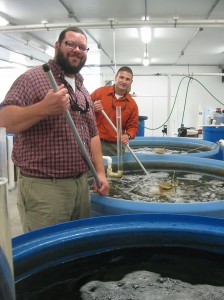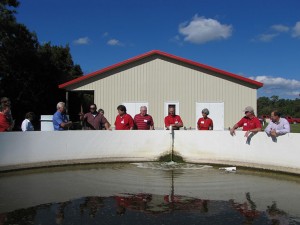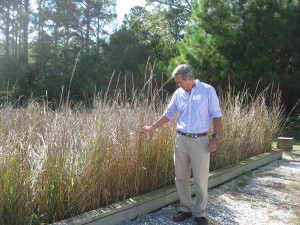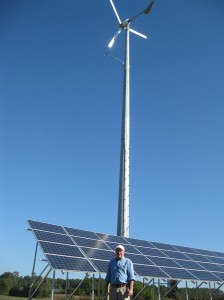By PAM SMITH
By design and location, North Carolina State University’s Marine Aquaculture Research Center, or MARC, is something of a hybrid — a mix of opportunity and challenge, science and economics.

Ryan Kelly, site manager, and Marc Turano, MARC interim director, oversee projects designed to help growers become more profitable. Photo by Pam Smith.
With access to salt water from nearby Sleepy Creek in rural Carteret County, researchers focus on growing marine species to help meet global consumer demand for fresh seafood that cannot be met by wild harvests.
“MARC is a tremendous resource to test new ideas on a small scale, or address saltwater species production issues in a controlled environment,” says Marc Turano, interim center director and North Carolina Sea Grant mariculture and blue crab specialist.
Turano describes MARC as a unique facility meant to help growers become more efficient and profitable.
Its 4,200-square-foot building houses a large wet lab with two replicated recirculating aquaculture systems, or RAS; four smaller wet-lab rooms with varying sized tanks; and a chemistry lab for water-quality testing and other analytical needs.
MARC also addresses a major financial obstacle for prospective marine aquaculture, or mariculture, entrepreneurs.
As Turano explains, freshwater aquaculture operations have thrived for 25 years across North Carolina, thanks, in part, to easy access to affordable water supplies — from mountain streams to groundwater.
On the other hand, costly price tags for coastal waterfront sites render salt water not very accessible or affordable for a start-up mariculture operation.
MARC is meant to demonstrate an economically feasible alternative. And, it’s all about location.
The center intentionally is situated on a six-acre site at the headwaters of Sleepy Creek, two miles away from Core Sound’s pricey shores. Yet, the creek provides an ample saltwater supply for the center’s multiple projects.
“There are many places like this one in coastal North Carolina with saltwater access — and affordable land costs,” Turano says. “We hope our accomplishments here will be a catalyst for mariculture development.”
COLLABORATIVE HISTORY
MARC’s academic home is NC State’s College of Agriculture and Life Sciences, or CALS, where Sea Grant has a decades-long partnership in aquaculture research. The center is a byproduct of the ongoing collaborative history.

An open house in October 2012 drew area residents and NC State supporters to MARC. Photo by Natalie Hamption/ NC State University.
MARC is located within the 275-acre Marshallberg Farm owned and operated by Sue and I.J. Won, a former NC State faculty member. In 2009, the Wons donated $500,000 to the CALS North Carolina Agriculture Foundation to establish the center and advance aquaculture in the coastal region.
The complex puts a modern spin on Carteret County farming and fishing traditions. The Wons’ grass-fed, certified organic Black Angus cattle roam on part of the spread. Rows of organic vegetable crops occupy still another plot.
But the Wons seem proudest of their venture into the realm of fish farming. They are cultivating Russian sturgeon for meat and caviar in a 27,600-square-foot fish barn. The facility, which is totally separate from MARC, houses 26 freshwater tanks, with a 400,000-gallon total capacity. Its state-of-the-art RAS was designed in part by Tom Losordo, now an NC State professor emeritus of agricultural engineering.
DOING THE SCIENCE
Turano and Losordo also conferred to tailor MARC’s recirculating system to meet complex saltwater aquaculture requirements — from intake to outflow.
The “made-to-order” setup is ideal for projects that are funded through the N.C. Fishery Resource Grant Program, or FRG, Turano says. Aquaculture and mariculture are among the priorities of the state program that is administered by Sea Grant.
For Nelson Paul, who owns a 33-acre farm in nearby Bettie, MARC and the FRG program provided the perfect opportunity to explore the economic feasibility of raising mud minnows, or mummichogs, in farm ponds.
Mud minnows, a denizen of coastal brackish waters, are the live bait of choice for recreational saltwater anglers — and not coincidentally, an important part of the diets of flounder, red drum and blue crab. In North Carolina, mud minnows are second only to bloodworms in total volume of sales by bait dealers.

NC State aquaculture researcher Harry Daniels checks out the experimental discharge “garden” at MARC. Photo by Pam Smith.
“We have been looking for an alternative crop to ensure the sustainability of the farm, with a special interest in the area of aquaculture,” Paul says.
But pond construction would be a costly investment, as well as a permanent alteration to valuable land that is farmed mostly in soy.
“It is productive, excellent soil — a good reason not to disrupt it for untested outcomes,” he points out.
Paul’s idea was to “do the science” at MARC to determine the spawning activity of mud minnows and the volume that could be cultured using a tank-based system. The data collected over a two-year period would be deciding factors in the economic viability of going forward with a startup aquaculture operation.
“Nelson was very hands on throughout the project,” Turano says. “He worked closely with Ryan Kelly, who manages day-to-day operations at the center.”
Paul’s middle-school aged son, Tim, often accompanied his dad on regular visits to MARC. The pair harvested mud minnow brooders, and participated in collecting, counting and sorting eggs.
Based on Paul’s findings, mud minnows in captivity don’t produce enough eggs to make it financially viable to move to the next level.
“Mother Nature determined it is not possible to create an assembly line for minnow production. We also learned that we would constantly have to change out brood fish to maintain brood stock — another practical and economic stumbling block,” Paul reports.
While his FRG did not spawn a new business, Paul views the project as a success story.
“Testing ideas is what the center is all about. Thanks to the FRG and MARC, we saved thousands of dollars by investigating the premise before investing in pond construction,” he adds.
Turano plans to continue the mud minnow research. “As with other marine species, the first few batches of fish typically have poor survival. We think we can overcome those challenges,” he says, explaining that other production methods and different salinities might improve the survival rate.
WORKS IN PROGRESS
Turano envisions MARC playing an increasingly important role in science and technology transfer to support the growth of mariculture.
“In North Carolina, growers regard university researchers and extension specialists as partners who are trying to make science work for their industry,” he says.
Nancy Sugg, who manages Castle Hayne Fisheries in Aurora, agrees. “All the research in the world doesn’t do any good unless it’s out there for public use. We’re lucky in North Carolina to have such an exchange of information. It takes the pressure off when you know you can call on experts to address certain issues,” she says.
For example, Turano is conducting a study with Sugg at MARC to evaluate the growth rates of various sizes of hybrid striped bass fingerlings.
Castle Hayne Fisheries is one of the state’s two hatcheries that culture hybrid striped bass.
During the Phase I hatchery stage, fry grow for 30 to 60 days to reach 1- to 3-inch fingerling size. Fingerlings then are graded according to size — small, medium and large.

The MARC facility enables Turano to test the most efficient feed regimines. Photo by Pam Smith.
“Nancy usually throws the smallest fingerlings back into the pond to allow them to continue to grow,” Turano explains. “But the question remains: Do they catch up in size? We want to study the throwbacks in a controlled tank environment to see how well they grow, compared to the other grades of fish.”
In another MARC study, Turano and Kelly are comparing feeds — one regular and one nutrient dense — for domesticated and wild hybrid striped bass.
“In theory, we should be able to feed less frequently with an enriched diet. But we have to minimize the fish’s fat content. Fatty fish are not desirable,” Turano explains.
Growers are looking to science to help find alternatives to fish meal as a protein source in feeding regimens. The ultimate goal is to reduce feed costs and maintain the omega-3 nutritional levels consumers desire.
THE GREEN CHALLENGE
While the location of MARC helps overcome the saltwater access issue for marine aquaculture, it also presents a set of environmental challenges for use and discharge.
To start with, water pulled from the salt creek at high tide must undergo a multistage filtration process before being pumped to the indoor tanks for various research projects.

Wes Carter, an engineer with Hart Power Solutions, says the wins tower and solar array help provide electric power for MARC. Photo by Pam Smith.
The added challenge comes in developing environmentally sound methods to deal with salt-laden and nutrient-rich wastewater — fish poop — from multiple recirculating tanks. This effluent flows to large tanks outside the building, where it is treated to remove nitrogen, phosphorous and solid fish waste.
The wastewater is pumped into a geo-textile “tube” which traps the solids, leaving clarified water.
That water is then filtered through a series of biological filters and finally flows through an experimental constructed wetland.
“The water leaving and returning to the creek must be as good or better than when we pumped it into the center,” Turano says. “We plan to work with other researchers from NC State to look at additional methods to tackle the wastewater issue.”
To make things even more interesting, as part of an NC State alternative energy study, a photovoltaic array and wind tower provide part of the energy needs for the complex.
An open house in October 2012 drew a crowd of area residents and university supporters. The event was part of Dean Richard Linton’s statewide get-acquainted tour, having assumed CALS leadership at the start of the fall semester.
Dave Eggleston, director of NC State’s Center for Marine Sciences and Technology, or CMAST, in Morehead City, explained that the wind and solar installations at MARC and CMAST are supported by a grant from the N.C. Green Business Fund.
“We are serious about looking at alternative energy sources,” Eggleston said. “Data from the wind and solar studies are acquired online in real time.”
The tower at MARC was erected in April 2012 and constructed with all recyclable or relocatable material, according to Wes Carter, an engineer with Hart Power Solutions. The company also constructed wind towers at Jockey’s Ridge, Jennette’s Pier and several schools on the Outer Banks.
Carter said the wind tower at MARC converts DC to AC and can produce 10,000 watts of energy. The windy season, from October through May, should deliver substantial energy benefits to the center as the tower blades swivel according to the prevailing winds.
The solar array has a 9,600-watt capacity and produces energy on sunny or cloudy days. It is set at a fixed 32-degree angle, a happy medium for all seasons, Carter adds.
Linton told guests at the open house that he was still in a “learning mode” after a short time on the job. But just two days into his statewide tour, he noted that it was clear to see the passion that stakeholders have in moving agriculture and aquaculture forward.
Turano sees a bright future for both freshwater and saltwater aquaculture in North Carolina.
“We have researchers working with growers who are committed to producing the highest quality products. And we have increasing consumer acceptance and trust that U.S. aquaculture growers, packers and distributors comply with strict food handling safety standards mandated by the Food and Drug Administration,” he concludes.
To learn more about North Carolina State University’s Marine Aquaculture Research Center, check out:
Aquaculture in North Carolina: NC State’s Marine Aquaculture Research Center written by Amy Freitag (with accompanying video) in Southern Fried Science.
Day two, dean’s tour: MARC and CMAST from the NC State University News Center.
Alternative Energy System Providing Power at N.C. State Marine Aquaculture Research Center from the NC Solar Center.
NCSU gets ‘green’ light for windmill featured in the Carteret County News-Times.
This article was published in the Winter 2013 issue of Coastwatch.
